Soil Management on Potato Land
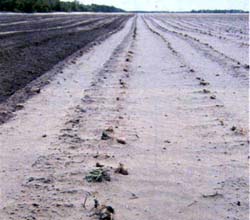
Potato Seed Pieces Exposed by Wind Erosion
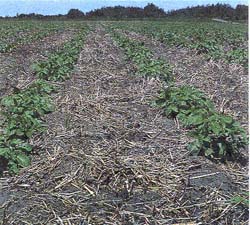
Potato Field with Adequate Protection from Wind Erosion
The potential for erosion on soils under potato production is much greater than it is on soils under cereal and oilseed production. Potatoes are traditionally grown on sandy textured soils. They require at least three weeks to emerge, and another three weeks for enough foliage growth to provide adequate ground cover. After harvest, the potato fields have little crop residue remaining on the surface because very little plant residue is produced and much of it is lost during harvest. Between harvest and the establishment of a crop canopy the next growing sea son can be a period when fields are extremely susceptible to erosion. Most of this erosion will be by wind.
The forces of wind on an unprotected field will cause the fine and medium sand particles from 0.1 to 0.5 mm in size to move in a bouncing or jumping action called saltation. These particles are lifted by the windstream and then blasted onto the ground downwind.
On contact, these particles dislodge other particles and force them into the windstream. This causes a chain reaction which increases in intensity as it moves across the unprotected field. Larger soil particles are dislodged and eroded by a process called surface creep (Figure 1).
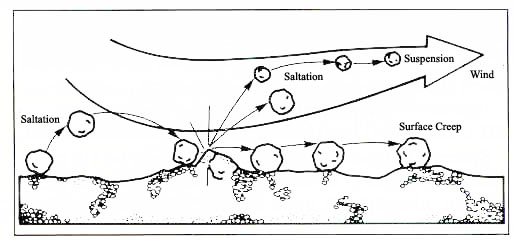
Soil Management Practices
Farmers growing potatoes must be careful to use and manage sandy soils to maintain productivity both today and in the long term. The following are some management options which are effective in reducing wind erosion on potato lands.
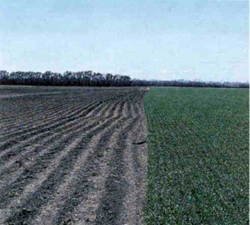
Fall Seeded Cereal after Early Potato Harvest
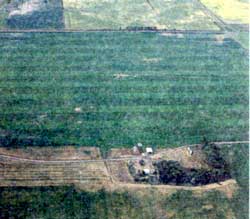
Quarter Section with Alternate Strips of Wheat and Potatoes
Fall Seeded Cover Crops
Cover crops provide vegetative cover in fall I and early spring for soils susceptible to erosion. In a rotation which includes potatoes, small grains such as wheat, barley and rye can be seeded immediately after the potato harvest in July, August and the early part of September. Seeding small grains after September 15 will be beneficial only when the fall is long and open without a killing frost. The recommended seeding rate for small grains is a bushel per acre (65 kg/ha). To ensure that protection remains adequate, lands seeded to cover crops should not be tilled until the following spring.
Shelterbelts
Fields in special crop rotations can benefit from shelterbelt planting. This is especially true of rotations which include low residue producing crops (edible beans, soybeans, potatoes, canola and flax). A distance of approximately 660 feet (201 m) between belts is recommended.
Spacing between trees in the belt should be 6 to 8 feet (1.8 to 2.4 metres). Where row crops are included in the rotation, shelterbelts must be spaced wide enough to accommodate row crop equipment.
Strip Cropping
Strip cropping will reduce the unsheltered width of erosion prone fields and limit saltation. Narrower fields perpendicular to the wind reduce erosion because the distance the wind is allowed to travel across a field to start soil movement is decreased. The width of strips will depend on the size of equipment used in the crop rotation and the erodibility of the soil.
Fields should be perpendicular to the May prevailing winds. The soil is most vulnerable to erosion in May, because the wind forces are strongest and fields have the least vegetative cover. Figure 2 shows the prevailing wind direction in May for various areas of the province.
Crop Residue Management
Maintaining enough crop residue on the soil surface will prevent wind erosion. If the crop before potatoes is a small grain, the following practices are recommended:
- The combine should have a straw and chaff spreader to distribute residue material in the field evenly. Harrows may also be necessary to help spread the straw and chaff.
- Fall tillage operations should result in a 65 per cent ground cover on sandy soils before seeding. The number of tillage operations that result in this amount of ground cover for various wheat and barley yields are shown in Table 1.
- Plant directly into previously fall-tilled fields with a conventional or modified potato planter.
- If no fall or spring tillage is carried out, the conventional planter can be modified to plant directly into standing stubble.
The following practices are recommended in handling potato residue.
- Attaching a vine chopper to a potato harvester eliminates the need for discing to anchor vines in the fall. The distribution of chopped residue will improve ground cover after harvest. Also, the chopped vines will not roll up in the wind.
- Anchoring the vines with a disc type implement with two-thirds of the discs removed. This practice leaves some vegetative cover and increases the surface roughness (ridging) of the soil. If the discs are not removed, the implement should be set to anchor the vines into the soil rather than tilling the soil and burying the residue.

65% Cover - Small Grain Residue
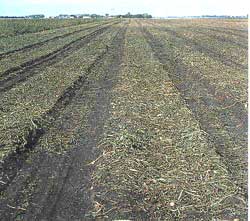
Use of a vine chopper results in a better distribution of potato residue
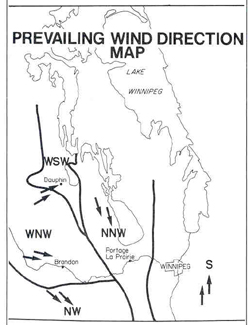
Prevailing wind direction map
| Soil Type | Crop Harvested bu/ac (kg/ha) |
Tillage Practices | |
| Loamy sands to sandy loams |
Wheat 40 (2700) |
Barley 80 (4300) |
not to exceed 3 cultivator operations whether done in fall or spring OR 1 tandem disc in fall plus 1 cultivator in spring |
| 30 (2060) | 60 (3200) | not to exceed 2 cultivator operations whether done in fall or spring | |
| 20 (1350) | 40 (2150) | no fall tillage - 1 cultivator operation in spring | |
Herbicides
Post-emergent herbicides to control broadleaf and grass type weeds are an effective alternative to pre-emergent herbicides. Tillage requirements of most pre-emergent herbicides leave the soil bare of residue cover. This results in a high potential for erosion.

